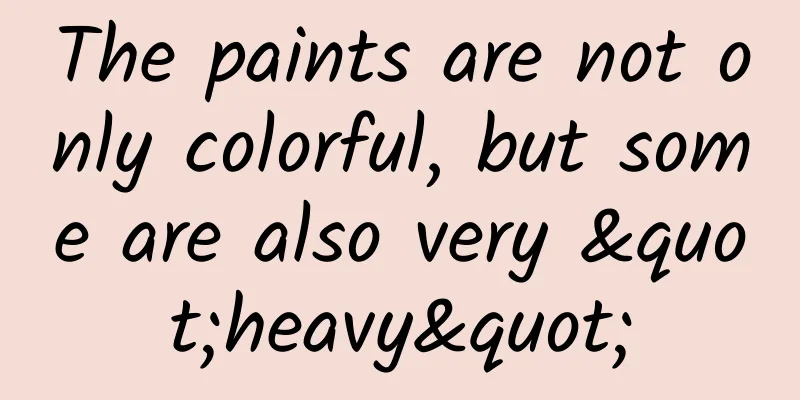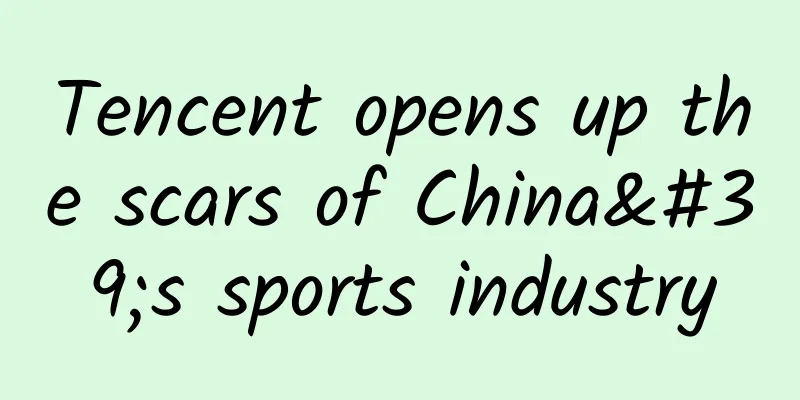The paints are not only colorful, but some are also very "heavy"

|
Did you know that some paints are not as glamorous as they seem? Some of them are very "heavy" in the process of production and use. Compiled by New Media Editor Song Meng In life, there are many colors that color the world we see. Throughout the ages, some paintings have also left the colors of time. However, although the various colors can be refreshing, if you pursue the history of pigments, the production process of some pigments is more unforgettable. The once popular "mummy brown" Brown is a color we always add when we paint. But many people may not know that this color was previously called "mummy brown". Does it sound scary? Actually, the truth is quite creepy. Because this brown color is really extracted from mummies. Yes, that’s the mummy that flashed through your mind! ▲Mummy (Picture from the article of "Amen Teaches You Photoshop") The pigment has good transparency and is very suitable for glazing, shading and skin tone. It is said that the flesh of the mummy will gradually crack over time, and the better the flesh, the richer the color. ▲Mummy paint color card (picture from the article of "Amen Teaches You PS" public account) Even such a horrible pigment was once a favorite of artists. In Europe from the 16th to the 19th century, this pigment was all the rage, and Raphael was one of the artists who loved it. He used this pigment to create many representative paintings. You can't imagine how such a terrible color could be turned into paintings in the hands of a calm and elegant artist. ▲"The Wedding of Saint Mary" (Picture from the article of the public account "Amen Teaches You PS") Later, due to excessive squandering, the number of mummies decreased year by year. At that time, an article in Time magazine quoted a London pigment merchant as saying: We may still have a few limbs and arms left, but not enough to make pigments. This was not because the merchants had a change of heart, but because they had squandered too much and there were really no more. After this, people gradually began to respect the importance of ancient Egyptian culture and art, and this once popular pigment slowly faded out of people's sight. Purple and red from dead animals In addition to "mummy brown", some pigments are obtained from the "corpses" of animals, such as purple and red. Among them, the purple shadow and purple light activated Monet's famous work "Haystacks". However, there is a purple called Tyrian purple, also known as murex purple and imperial purple, which was regarded as a symbol of the emperor in ancient times. But the extraction process of this dye is completely, and it cannot be described as just "disgusting". (Picture from the article on the public account "Amen Teaches You PS") This purple pigment comes from the secretions of a sea snail on the seafloor. The rotting snail bones are mixed with wood ash and then fermented in a mixture of rancid urine and water. The entire extraction process emits an intoxicating stench. It is said that it takes 250,000 conches to produce half an ounce of this purple, but that is only enough to dye a Roman robe. Such a high cost makes this purple a symbol of status. (Picture from the article on the public account "Amen Teaches You PS") The monopoly on purple did not fade until the 15th century, when the Byzantine Empire fell. Purple did not become popular until the first synthetic dyes were put on the market in the 19th century. Even then, purple was still favored by the royal family. The origin of red pigment is not that simple. In the 16th and 17th centuries, carmine was very popular and became the third largest export product after gold and silver. Raphael, Rembrandt and Rubens all loved to use this pigment to enhance the durability, thickness and density of the painting. (Picture from the article on the public account "Amen Teaches You PS") However, this pigment powder is extracted from a kind of cochineal insect that grows on Mexican cacti and pear trees! The production process is quite "bloody". People pick it from the cactus, crush it, filter it, and finally get beautiful and bloody carmine. (Picture from the article on the public account "Amen Teaches You PS") Trivia: In the past, the powder extracted from this insect was also used in the manufacture of cosmetics - lipstick and blush (this one is non-toxic!!!) In my country, the main types of red mineral pigments include cinnabar (also known as cinnabar), hematite, zeolite, red marl, etc. Among them, cinnabar, also known as cinnabar, cinnabar, cinnabar, etc., is mainly composed of mercury sulfide, and is often mixed with realgar, apatite, asphaltene, etc. Ancient Chinese craftsmen had gained a lot of experience in the manufacture and purification of cinnabar. In the process of making cinnabar, a variety of colors appeared, the upper layer was yellow, the lower layer was dark, and the middle vermilion was the best color. Many unearthed cinnabars were exactly vermilion. The love-hate relationship between "chrome yellow" and "lead white" In fact, some pigments not only have life colors, but can even be toxic or "urine". For example, Van Gogh was particularly fond of using yellow. This pigment was once called "chrome yellow" and has been proven to cause mental disorders. ▲Paintings by Van Gogh (Picture from the article of the public account "Amen Teaches You PS") Van Gogh's thick painting technique required applying many layers of thick paint to his paintings. He used a lot of pigments with extremely high lead content when mixing colors, such as white lead (lead carbonate) and chrome yellow (lead chromate). These pigments are highly toxic and excessive use can cause lead poisoning. Secondly, there is another yellow that is more "heavy", that is Indian yellow. This yellow pigment originated in India and is made from the urine of cows that are only fed mango leaves and water. Since cows cannot digest mango leaves, their urine will contain bile, which can be evaporated and filtered to obtain Indian yellow. ▲Indian yellow (picture from the article of "Amen Teaches You PS") However, these cows were skinny and pale because they ate only mango leaves. In India, it was considered sacrilegious to not take good care of cows, so in the 19th century, it was banned by the Indian government. In Europe, many artists are fond of this clear and bright yellow because it is very suitable for showing the changes in light and shadow. In addition, there is a pigment containing lead. In the past, the Dutch method of producing white pigment was to spread cow and horse manure layer by layer on lead and vinegar, seal it in a sealed room, and after three months, these materials would degrade into a pure white powder. However, scientists in the 19th century had already confirmed that lead was poisonous, but it was not until 1978 that the United States banned the production of white lead. ▲Aristocrat with whitened face (Picture from the article of “Amen Teaches You Photoshop”) The reason is that the white painted by this pigment has a beautiful luster, which makes it not only shine in paintings, but also leaves a unique mark on the faces of Roman ladies, Japanese geishas, Chinese ladies, etc. However, in later periods, this toxic lead white was replaced by non-toxic titanium white and zinc white for creating paintings. “Toxic Green” represents life and also endangers life In addition to those pigments with more "exquisite" sources, there is another pigment that is quite special in history. That is the green that we must use when painting landscapes, vegetables, etc. Although green represents nature and rejuvenation, its color powder has historically been the most poisonous. In 1775, Swedish chemist Carl Wilhelm Scheele invented a deadly hue - Scheele Green. ▲A painting made of Scheele Green (picture from the article of the public account "Amen Teaches You PS") Scheele Green was bright in color, not easy to fade, and cheap to produce, so it became very popular in the 19th century, from wallpaper, clothing, accessories to food, medicine, toys and the construction industry. But its color powder contains highly toxic arsenic, and dye workers can easily get the dye on their skin, causing ulcers. (Picture from the article on the public account "Amen Teaches You PS") It is said that even the wallpaper in Napoleon's bedroom used a lot of Scheele Green at that time. Many historians believe that this led to Napoleon's early death. More than 20 years later, a brighter "poison green" 2.0 pigment was born - Paris Green, which replaced Scheele Green as the main green pigment. But Paris Green is also poisonous. It is a mixture of brass and arsenic, and can even be used as a rodenticide and insecticide. ▲Paris Green (Picture from the article of "Amen Teaches You PS") But many Impressionist masters loved it. Among them, Monet, Cézanne, and Renoir used Paris Green to create vivid emerald-like landscapes. Although both green pigments contain highly toxic chemicals, people's exploration of pigments and pursuit of beauty have never stopped. It is precisely because of the step-by-step exploration and attempts of our predecessors that we can get today's fresh and "harmless" green and give green more positive meanings. Real gold creates a "luxury style" Gold is one of the important decorative pigments in fine-brush flower and bird paintings. Gold foil is made by hammering real gold, and its main production area is Suzhou, China, so it is commonly known as "Su Chi". ▲Gold foil (Picture from the article of "Palm Calligraphy and Painting") There are many ways to use gold leaf, including gold dusting, gold sprinkling and gold beating, among which gold dusting is the most widely used. Gold dusting is to grind the gold leaf into fine mud with your fingers and glue in a dish, and then use a brush to draw with it. There are also gold bowls and gold beans, which can also be used directly. In addition, light glue is used as an adhesive to evenly and evenly apply gold foil on the picture. This method of priming is the most widely used in Japanese paintings and has a strong decorative beauty. (Picture from the article on the official account of "Palm Calligraphy and Painting") In addition, there is also the term "mud gold". Pure gold is bright, pure, and unchanging, while other substitutes are generally made of copper powder and will turn black and dark in a very short time. Ultramarine Blue, More Expensive Than Gold Ultramarine is a color that is often used in painting. But do you know that in the past, ultramarine was simply a symbol of the rich? This rich blue comes from lapis lazuli quarries in Afghanistan. It was mined six thousand years ago and shipped to Egypt and then to Europe. (Picture from the article on the public account "Amen Teaches You PS") Europeans call this color Ultra Marine, which means it comes from overseas and needs to be carefully ground by blenders. This precious blue obtained through such laborious efforts is often used to color the Virgin Mary's robe in oil paintings, and its price is more expensive than gold. Although expensive, ultramarine has always been one of the indispensable colors on the palette of medieval painters. This stage also lasted for hundreds of years. Because the cost of extracting ultramarine through natural methods was too high, in order to encourage the pigment industry, France began to offer a high price reward for the industrial method of ultramarine in 1824. It was not until four years later that a French chemist finally invented artificial ultramarine with the same chemical composition as the purest lapis lazuli. Since then, artificial synthesis has gradually replaced the long-standing method of making ultramarine from lapis lazuli. However, nowadays, more and more synthetic pigments are replacing these precious pigments. |||| (Information is compiled from the official accounts of "Institute of Physics, Chinese Academy of Sciences", "Palm Calligraphy and Painting", "Amen Teaches You PS", etc.) Produced by: Science Central Kitchen Produced by: Beijing Science and Technology News | Beijing Science and Technology Media Welcome to share to your circle of friends Reproduction without authorization is prohibited |
<<: The truth about brain-to-brain interfaces: Is the "telepathy" that Musk pursues possible?
>>: Pork also has health advantages! Eating it right can replenish your nutrition
Recommend
There is a poison called "seven aunts and eight aunts", let's see how major brands can help you detoxify
As the year draws to a close, in addition to the ...
You will regret it if you don't read this! Eating less meat leads to mental illness? Meat consumption is closely linked to depression, anxiety, and dementia
Meat, as an important component of the human diet...
Collection: 68 information flow ads and SEM learning website resources are available for free!
01. CNZZ -UDplus Website: udplus.umeng.com Note: ...
Who was the first person to reach the North Pole?
Many people are familiar with the story of Antarc...
Is it expensive to produce the Zhuhai ticketing mini program? Zhuhai Ticketing Mini Program Production Cost and Process
How much does it cost to produce the Zhuhai ticke...
A new way to innovate e-commerce - earn money by buying in groups!
When I was talking with a friend last week, I cam...
Perfect Diary’s secret to live streaming on Tik Tok!
Tik Tok has always been an important platform for...
Song Hongbing Hong Academy 2021 live class video, building a new financial thinking system
Song Hongbing Hong Academy 2021 live class video,...
The distribution map of Chinese surnames has been released. Let’s see where your roots are.
It is estimated that 87% of China's populatio...
What are the specific differences between server rental and server hosting?
What is the difference between server rental and ...
Second-tier e-commerce marketing | Secrets to creating hot-selling products in the jewelry and watch industries!
In the past two years, jewelry, accessories and w...
Who are the ones being harvested through medical beauty and oral community marketing?
Since medical aesthetics and dentistry caught the...
Latest research! New artificial intelligence model can predict the effect of brain glioma treatment
Gliomas are tumors that originate from brain glia...
Haval's sales have dropped sharply, while the new brand WEY started strong but ended weak. Where is the turning point for Great Wall Motors?
Great Wall Motors' recent sales are not optim...
Douyin e-commerce data analysis case
Douyin e-commerce , which is in its bonus period,...









